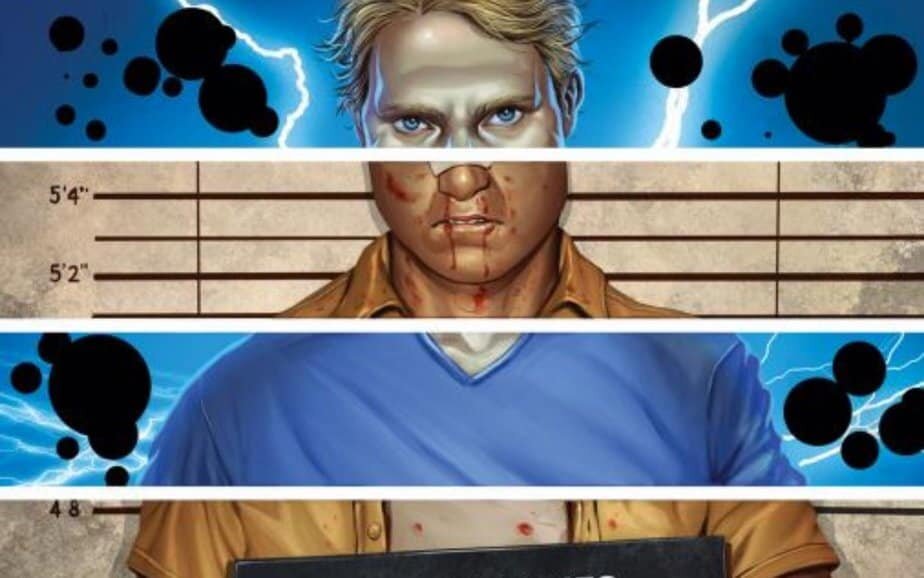Ed Piskor’s Wizzywig Story
Ed Piskor’s Wizzywig is a weird read. I absorbed the 2011 comic a year ago on a long train journey and spent most of that time simultaneously fascinated and wondering why.
Loosely based on the lives of real hackers Kevin Mitnick, Kevin Poulsen, and Joybubbles, the story follows another composite-Kevin, a genius kid growing up in the 80s, as he stumbles into infamy as a computer hacker and apparent criminal. Kevin’s story is intercut with flashes to the future (often scenes of his childhood friend defending him), and from them we know he will be arrested and that he will spend years unfairly behind bars.
A conventional version of this story might lean into Kevin’s characterisation, maybe spending time establishing his motivations or making him likeable and compelling. That is not Wizzywig. Both Kevin’s timeline and the future segments present him as naïve to the point where he goes beyond sympathetic and instead basically just exists.
He is bullied, his crimes are either accidents or jokes gone wrong, and always victimless, his occasional moments of manipulation or cruelty are immediately forgotten by the narrative. Kevin also lacks any sort of ideology or even, really, motivation. He’s a poor kid, raised by an off-panel grandmother, but we don’t see enough of that relationship to care about it and there’s not really even a sense that Kevin is aware of the unfairness of his own situation. He is not a class warrior acting against capitalism.
Kevin drives the Wizzywig plot but in terms of interiority or aims, he is an almost entirely inactive protagonist. Piskor’s art plays into this too: in a world full of detailed, often-grotesque cartoon characters, Kevin is remarkably bland. His face stays the same throughout Wizzywig even as the other characters age, and his eyes are blank circles. Kevin is the sort of character created when a writer does not care about them.
And despite that, Wizzywig is entirely engrossing. To understand why you need to understand Piskor, and to understand Piskor you need to look at his biography.
Wizzywig compared to Grand Design and Hip-Hop Family Tree
Ed Piskor deals in big pictures. His comics are creation narratives – not stories of one person, but of a whole history. His clearest foray into mainstream comics, X-Men: Grand Design (Marvel, 2018-2019)is a retelling of that entire franchise: streamlined and simplified to make the work of seventy years and hundreds of writers, artists, and editors, into one cohesive whole. It would have been a daunting task even if Piskor had only been interested in the footnotes, but the detail he employed throughout makes the end result remarkable.
This is just as obvious in his longest running series: Hip-Hop Family Tree (which ran as single pages in Boing Boing, 2012–2015 before being published as collected editions from Fantagraphics, 2013–2016). Piskor applied the same diligent attention to detail to real world music history as to comic book soap opera and created what is effectively a mythology of a musical genre, the artists themselves coming and going and the music evolving through them.
It is impossible to imagine Piskor working on a project which did not personally fascinate him. Every page he produces tells you just how much obsessive research he has poured into what he’s doing, and the magic trick is that he makes it fascinating for the reader too. From Hip-Hop to the X-Men, or in the case of Wizzywig, the early origins of hacking, Piskor cares. And that passion tells you the real star of the book: not Kevin, but what Kevin does.
As a mainstream pleb, my first exposure to Piskor was with Grand Design- specifically I picked it up because I heard him talking about the project on podcast X-Plain the X-Men. Also as a pleb, I went into it knowing much of the history of the franchise already. It is hard to say if that knowledge made my experience reading Piskor’s work better or worse- but I think it helped. If I was someone who got precious about the pre-existing canon, I might have enjoyed it less, but instead Piskor’s work read to me like a genuine love letter to decades worth of often silly comics.
Grand Design is not just a recap, it is a story which pulls out themes and connections, builds bridges where they weren’t and does it all without turning into a textbook. Piskor excels at finding moments of comedy and knowing when to allow something room to breathe, and he’s just as good at leaning into drama and horror. The famous moment of Jean Grey’s sacrifice in the Dark Phoenix Saga is given the space it needs to move from tragedy to horror to victory- from her disintegrating corpse to a majestic gigantic firebird.


It says a lot that he can balance the tonal gymnastics necessary, and much of that comes down to the art style: Piskor’s own exaggerated, distinctive work is coloured in a warm palette and ink dot overlay. The comics look retro without losing the trademark detail of his style- something very appreciated when dealing with dozens of characters and complicated stories. On the surface it might seem weird that Marvel went to an indie creator like Piskor for this, but there is just nobody else who could have done what he did.
The Tone of Wizzywig
All of this brings me back to Wizzywig. While it lacks the emotional highs and lows of Grand Design, it keeps the razor-sharp focus on details. Kevin might be a flimsy protagonist, but as you follow his story you absorb Piskor’s obsession with hacking: from early phone phreaking to sociopathic social engineering to coding, it is less like reading a story and more like having a great conversation with a knowledgeable friend- complete with infectious enthusiasm.
Piskor does his same magic trick of holding your interest with artistic details, jokes and pacing, and it transforms what could have become wall of text in less precise hands. Again, his art is a big part of this. Wizzywig is printed in black and white, which is perfect for something dealing with the subcultures of the 80s and 90s.
Everything is rough and ugly, the grounded, edgy feel is hard and bitter without losing the cartoonish comedy Piskor does so well. There’s as much illustrative detail as there is textual- if you’re just reading Piskor for the text and not looking at every face you’re going to miss out.
Honestly, even though I started this by speaking sceptically about Kevin as a protagonist, he’s the perfect person to follow through a world like Wizzywig’s. More personality in the lead character would overcrowd a story with so much content crammed into everything else.
Right now, Piskor is working on a new creator owned series: Red Room: The Antisocial Network (Fantagraphics, 2021-). It’s an anthology series about the dark web- the first issue focusses on online snuff films- and it’s markedly different from his previous work in that it is story and character driven- but somehow Piskor has managed another magic trick and kept the addictive obsessiveness too.
Piskor’s fascination with the underbelly of the internet is as obvious here as phone phreaking was in Wizzywig, even if it is coming across in character beats rather than narration. His art has more space to be grotesque than ever before – and he is using it. Red Room is horrible, but just like everything Piskor’s written, it is impossible to look away.
Want more Comic Book Articles?
RELATED ARTICLES:
1. Celebrate 20 Fists #1 with Pride Variant
2. Rylend Grant’s SUICIDE JOCKEYS out through Source Point Press
3. It’s Clobberin’ Time! 31 Best Quotes from The Thing
4. How to write a Comic Book outline









